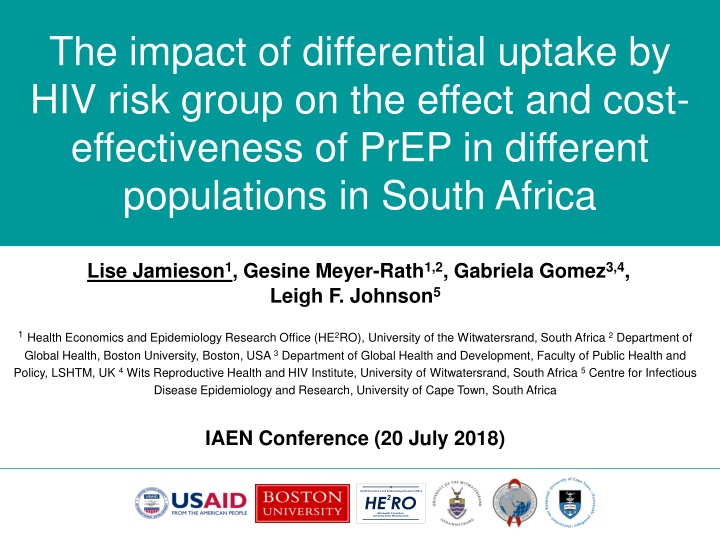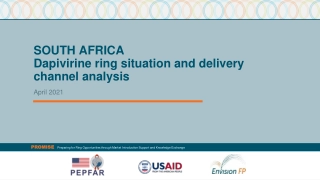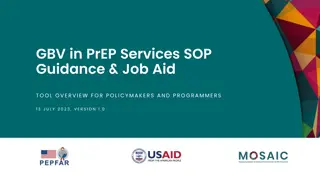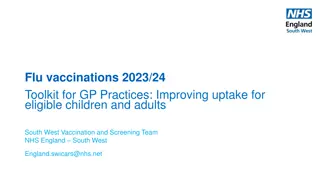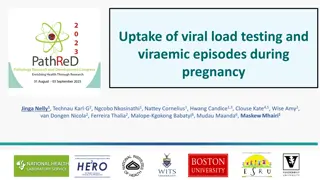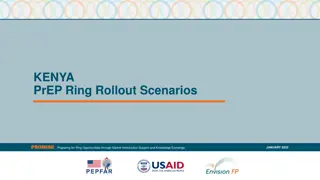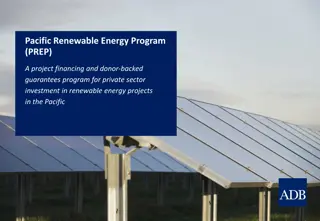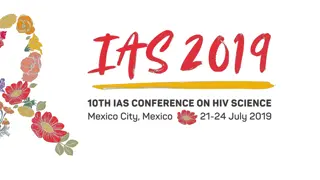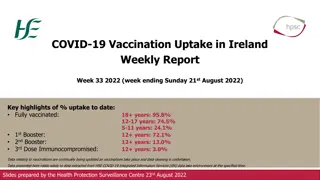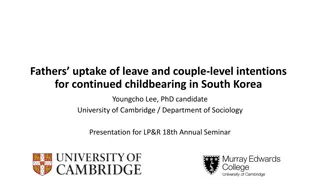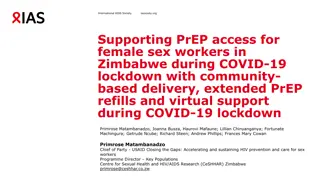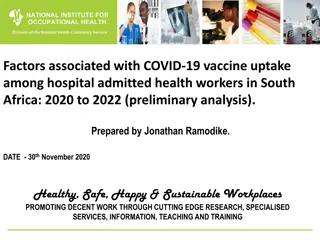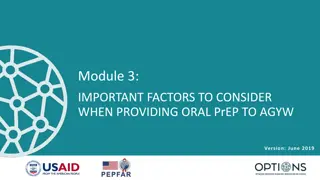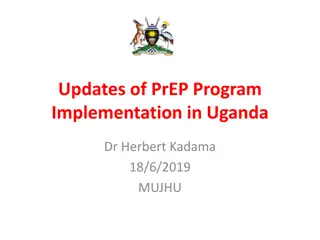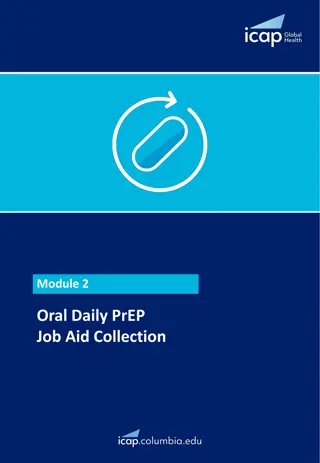Impact of PrEP Uptake on Cost-Effectiveness in South Africa
Analyzing the differential PrEP uptake among HIV risk groups and its effect on cost-effectiveness in various populations in South Africa. Evaluating the impact of providing PrEP to different target populations, assessing cost-effectiveness, and exploring potential changes if individuals self-select based on risk.
Download Presentation

Please find below an Image/Link to download the presentation.
The content on the website is provided AS IS for your information and personal use only. It may not be sold, licensed, or shared on other websites without obtaining consent from the author.If you encounter any issues during the download, it is possible that the publisher has removed the file from their server.
You are allowed to download the files provided on this website for personal or commercial use, subject to the condition that they are used lawfully. All files are the property of their respective owners.
The content on the website is provided AS IS for your information and personal use only. It may not be sold, licensed, or shared on other websites without obtaining consent from the author.
E N D
Presentation Transcript
The impact of differential uptake by HIV risk group on the effect and cost- effectiveness of PrEP in different populations in South Africa Lise Jamieson1, Gesine Meyer-Rath1,2, Gabriela Gomez3,4, Leigh F. Johnson5 1Health Economics and Epidemiology Research Office (HE2RO), University of the Witwatersrand, South Africa 2Department of Global Health, Boston University, Boston, USA 3Department of Global Health and Development, Faculty of Public Health and Policy, LSHTM, UK 4Wits Reproductive Health and HIV Institute, University of Witwatersrand, South Africa 5Centre for Infectious Disease Epidemiology and Research, University of Cape Town, South Africa IAEN Conference (20 July 2018) Health Economics and Epidemiology Research Office HE RO 2 Wits Health Consortium University of the Witwatersrand
Objectives What is the cost and epidemiological impact of providing PrEP to different target populations in South Africa? What would be the most cost-effective population to target? Would this change if people self-selected based on increased risk? Health Economics and Epidemiology Research Office HE RO 2 Wits Health Consortium University of the Witwatersrand
Process Worked alongside the DoH s PrEP technical working group while developing the PrEP guidelines for South Africa Regularly updated cost and effectiveness data based on experiences in ongoing demonstration projects Results informed priority setting and budgets for roll- out (though not targets) Ongoing discussion about between PrEP only and integration of other (STI/prevention) services into PrEP Health Economics and Epidemiology Research Office HE RO 2 Wits Health Consortium University of the Witwatersrand
Modelling methods The epidemiological impact was ascertained using the Thembisa model, a compartmental HIV transmission model fitted to the South African HIV epidemic PrEP was scaled-up linearly over 3 years from 2019 to target coverage of 18% for young adults and adolescents, pregnant women 70% for MSM 95% for FSW Sub-scenarios in which only the high risk sub-population would select to initiate PrEP, emulating self-selection of those who deem themselves at high risk of HIV acquisition PrEP effectiveness: 65% (85% in MSM), time on PrEP: 2 years Evaluated the impact of PrEP on the entire HIV programme over 20 years (2019-2038)
PrEP unit cost Provider perspective Ingredients-based costing, based on PrEP guidelines Assumes generic drugs, lower staff cadre, includes demand creation and targeting costs Resource use data based on PrEP demonstration projects to female sex workers (FSW) [Project TAPS, Wits RHI], men who have sex with men (MSM) [ANOVA], adolescent girls and young women [ACCESS] Separate unit cost for young adults (20-24 yrs), adolescents (15-19 yrs) of both genders, pregnant women, FSW and MSM Health Economics and Epidemiology Research Office HE RO 2 Wits Health Consortium University of the Witwatersrand
PrEP unit cost (2017 USD) per person per year Young women (20-24) Female adolescents (15-19) Young men (20-24) Male Pregnant women FSW adolescents (15-19) MSM $160 $160 $100 $162 $159 $159 $158 First year $140 $140 $140 $139 $139 $139 $138 Follow-up PrEP cost per person per year is $140-160 (non- pregnant), $100 (pregnant) Average cost of ART = $286 per person per year Health Economics and Epidemiology Research Office HE RO 2 Wits Health Consortium University of the Witwatersrand
PrEP unit cost: Cost drivers 0.3% M+E 0.3% M+E Combination prevention STI Combination prevention 2% 2% 2% 2% STI 6% Training 6% Training HTS 5% HTS 5% Social Social 10% 12% mobilisation mobilisation Counselling+ dispensing Counselling+ dispensing 6% 7% Overheads, 9% Overheads, 9% Labs, 12% Labs, 22% Drugs, 43% Drugs, 38% FIRST YEAR FOLLOW-UP YEAR YOUNG WOMEN
Impact of PrEP on HIV incidence Baseline 0.60% 1.6% 0.50% 1.4% 1.2% 0.40% HIV incidence 1.0% 0.8% 0.30% 0.6% 0.4% 0.20% 0.2% Virtual elimination (incidence < 0.1%) 0.10% 0.0% 1986 1990 1994 1998 2002 2006 2010 2014 2018 2022 2026 2030 2034 2038 0.00% 2018 2020 2022 2024 2026 2028 2030 2032 2034 2036 2038 Baseline YW (20-24), HR Fem_adol (15-19), HR FSW YM (20-24), HR Mal_adol (15-19), HR YW (20-24), all Fem_adol (15-19), all Pregnant women YM (20-24), all Mal_adol (15-19), all MSM
Impact of PrEP on new HIV infections 300,000 Baseline 250,000 YW (20-24), all New HIV infections YW (20-24), HR 200,000 Fem_adol (15-19), all Fem_adol (15-19), HR 150,000 Pregnant women FSW YM (20-24), all 100,000 YM (20-24), HR 88,000 new HIV infections Mal_adol (15-19), all 50,000 Mal_adol (15-19), HR MSM 0 2018 2019 2020 2021 2022 2023 2024 2025 2026 2027 2028 2029 2030 2031 2032 2033 2034 2035 2036 2037 2038
Impact of PrEP on new HIV infections averted 16,000 14,000 New HIV infections averted 12,000 YW (20-24), all 10,000 Fem_adol (15-19), all Pregnant women 8,000 YM (20-24), all 6,000 Mal_adol (15-19), all MSM 4,000 2,000 0 2018 2019 2021 2022 2023 2024 2025 2026 2027 2028 2029 2031 2032 2033 2034 2035 2036 2037 2038 2020 2030
Impact of PrEP on new HIV infections averted 16,000 14,000 YW (20-24), all New HIV infections averted 12,000 YW (20-24), HR Fem_adol (15-19), all 10,000 Fem_adol (15-19), HR Pregnant women 8,000 FSW YM (20-24), all 6,000 YM (20-24), HR 4,000 Mal_adol (15-19), all Mal_adol (15-19), HR 2,000 MSM 0 2018 2019 2021 2022 2023 2024 2025 2026 2027 2028 2029 2031 2032 2033 2034 2035 2036 2037 2038 2020 2030
Impact of PrEP on incremental cost of HIV programme (2017 USD) 80 70 60 Incremental cost (USD, millions) 50 Baseline 40 YW (20-24), all Fem_adol (15-19), all 30 Pregnant women 20 YM (20-24), all 10 Mal_adol (15-19), all 0 MSM -10 -20 -30 2019 2021 2022 2023 2024 2025 2026 2027 2028 2029 2030 2031 2032 2033 2034 2035 2036 2037 2038 2020
Impact of PrEP on incremental cost of HIV programme (2017 USD) 80 70 Baseline 60 Incremental cost (USD, millions) YW (20-24), all 50 YW (20-24), HR Fem_adol (15-19), all 40 Fem_adol (15-19), HR 30 Pregnant women 20 FSW 10 YM (20-24), all YM (20-24), HR 0 Mal_adol (15-19), all -10 Mal_adol (15-19), HR -20 MSM -30 2019 2021 2022 2023 2024 2025 2026 2027 2028 2029 2030 2031 2032 2033 2034 2035 2036 2037 2038 2020
PrEP cost effectiveness (2019-38) Female adolescents (15-19) Male Young women (20-24) Pregnant women Young men (20-24) FSW MSM adolescents (15-19) Risk group All HR All HR All HR All HR All HR All Coverage No. of person years on PrEP [millions] New HIV infections averted [thousands] (% change) Incremental cost [millions 2017 USD] (% change) ICER [2017 USD/HIV infection averted] 18% 18% 18% 18% 18% 95% 18% 18% 18% 18% 70% 9.8 1.9 7.3 2.0 6.3 2.4 10.2 4.0 5.8 2.6 4.4 110 (2.9%) 88 159 (4.3%) 140 (3.7%) 76 162 (4.4%) 139 (3.7%) 130 (3.4%) 99 94 199 (5.5%) (2.3%) (2.0%) (2.6%) (2.4%) 1,186 (2.7%) 122 (0.3%) 749 (1.7%) 45 843 (1.9%) 75 1,218 (2.8%) 377 (0.9%) 666 (1.5%) 232 (0.5%) 345 (0.8%) (0.1%) (0.2%) 10,776 1,386 4,718 319 11,062 464 8,781 2,894 6,755 2,469 1,730
PrEP cost effectiveness (2019-38) Female adolescents (15-19) Male Young women (20-24) Pregnant women Young men (20-24) FSW MSM adolescents (15-19) Risk group All HR All HR All HR All HR All HR All Coverage No. of person years on PrEP [millions] New HIV infections averted [thousands] (% change) Incremental cost [millions 2017 USD] (% change) ICER [2017 USD/HIV infection averted] 18% 18% 18% 18% 18% 95% 18% 18% 18% 18% 70% 9.8 1.9 7.3 2.0 6.3 2.4 10.2 4.0 5.8 2.6 4.4 110 (2.9%) 88 159 (4.3%) 140 (3.7%) 76 162 (4.4%) 139 (3.7%) 130 (3.4%) 99 94 199 (5.5%) (2.3%) (2.0%) (2.6%) (2.4%) 1,186 (2.7%) 122 (0.3%) 749 (1.7%) 45 843 (1.9%) 75 1,218 (2.8%) 377 (0.9%) 666 (1.5%) 232 (0.5%) 345 (0.8%) (0.1%) (0.2%) 10,776 1,386 4,718 319 11,062 464 8,781 2,894 6,755 2,469 1,730
PrEP cost effectiveness (2019-38) Female adolescents (15-19) Male Young women (20-24) Pregnant women Young men (20-24) FSW MSM adolescents (15-19) Risk group All HR All HR All HR All HR All HR All Coverage No. of person years on PrEP [millions] New HIV infections averted [thousands] (% change) Incremental cost [millions 2017 USD] (% change) ICER [2017 USD/HIV infection averted] 18% 18% 18% 18% 18% 95% 18% 18% 18% 18% 70% 9.8 1.9 7.3 2.0 6.3 2.4 10.2 4.0 5.8 2.6 4.4 110 (2.9%) 88 159 (4.3%) 140 (3.7%) 76 162 (4.4%) 139 (3.7%) 130 (3.4%) 99 94 199 (5.5%) (2.3%) (2.0%) (2.6%) (2.4%) 1,186 (2.7%) 122 (0.3%) 749 (1.7%) 45 843 (1.9%) 75 1,218 (2.8%) 377 (0.9%) 666 (1.5%) 232 (0.5%) 345 (0.8%) (0.1%) (0.2%) 10,776 1,386 4,718 319 11,062 464 8,781 2,894 6,755 2,469 1,730
PrEP cost effectiveness (2019-38) ICER PrEP intervention (USD/HIV averted) Female adolescents (15-19), HR 319 FSW 464 Young women (20-24), HR 1,386 MSM 1,730 Male adolescents (15-19), HR 2,469 Young men (20-24), HR 2,894 Female adolescents (15-19), all 4,718 Male adolescents (15-19), all 6,755 Young men (20-24), all 8,781 Young women (20-24), all 10,776 Pregnant women 11,062
Uncertainties Modelling: Successful selection of high risk sub-population Effectiveness modelled: 65% (85% MSM) Time on PrEP: 2 years Coverage (targets/ demand) PrEP cycling Cost: Integration of other services (STI, prevention) into PrEP Health Economics and Epidemiology Research Office HE RO 2 Wits Health Consortium University of the Witwatersrand
Uncertainty: PrEP coverage impact on HIV (2019-38) 25% 20% YW (20-24), all % new HIV infections averted YW (20-24), HR Fem_adol (15-19), all 15% Fem_adol (15-19), HR Pregnant women FSW 10% YM (20-24), all YM (20-24), HR Mal_adol (15-19), all 5% Mal_adol (15-19), HR MSM 0% 10 15 20 25 30 35 40 45 50 55 60 65 70 75 80 85 90 95 5 Coverage (%)
Uncertainty: PrEP coverage impact on cost (2019-38) 7.0 6.0 YW (20-24), all Incremental cost (USD, billions) YW (20-24), HR 5.0 Fem_adol (15-19), all Fem_adol (15-19), HR 4.0 Pregnant women FSW 3.0 YM (20-24), all YM (20-24), HR 2.0 Mal_adol (15-19), all Mal_adol (15-19), HR 1.0 MSM 0.0 35 45 Coverage (%) 10 15 20 25 30 40 50 55 60 65 70 75 80 85 90 95 5
Conclusion PrEP averts between 2.0% and 5.5% of new HIV infections in the next 20 years overall impact of PrEP on the HIV epidemic is relatively small, regardless of target population and self-selection by risk PrEP increases cost of the HIV programme by 0.1% to 2.8% in the next 20 years Successful targeting of high risk groups can render it more cost effective or even cost-saving in the longer terms Most cost-effective is PrEP provision to high-risk female adolescents, then FSW, then high-risk young women, then MSM, then high-risk young men and adolescents, then all others. PrEP provision to pregnant women is the least cost effective option. Health Economics and Epidemiology Research Office HE RO 2 Wits Health Consortium University of the Witwatersrand
